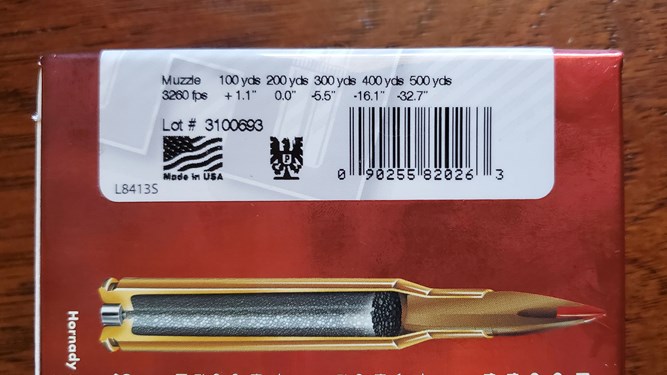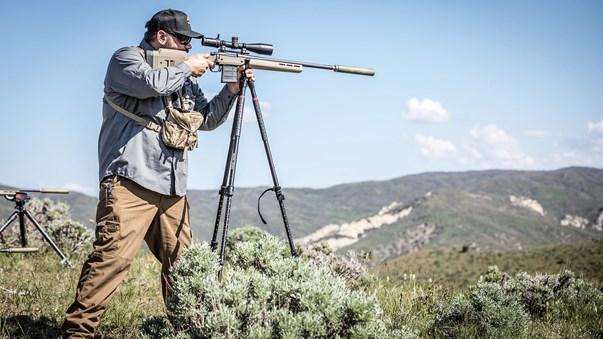
The most commonly hunted big-game animal in North America is the white-tailed deer, and most of them are shot from about 100 yards away or closer. This is an easy shot to make under decent conditions. Your rifle is probably sighted in at 100 or 200 yards, and the vital zone on a deer is the size of a paper plate, so with almost any common big-game caliber, you just hold the crosshairs on the deer’s vitals and touch the shot off. Assuming nothing goes big-time wrong like a ferocious gust of wind or an errant jerk of the trigger, the projectile goes where you were aiming and the deer is fatally wounded. Easy peasy.
When the distance starts to increase, though, things get more complicated. If you’re hunting the expansive greenfields of the South, the wide-open prairies of the Midwest or the mountains and valleys of the West, you might never get a shot that’s within 100 yards. Yes, you should get as close as you can to the animal, but you should also be prepared to shoot at 300 or 400 yards or more—and that’s not something you do on the fly.
If you’d like to stretch out the distance at which you can make ethical shots on game, here’s how to get there.
1. Understanding the Ballistics
To understand longer-range shooting, you need a basic understanding of ballistics. When a projectile leaves the muzzle of the gun, it travels in an arc, briefly rising a bit before beginning to fall. The crosshairs of the scope are set at the point where that trajectory intersects the target at the distance you sighted the gun in at. This is somewhat complicated math, but most ammo manufacturers print a simple drop chart on each box of ammo that tells you how far a projectile falls at a given yardage.

Let’s take this box of .300 Win Mag ammo as an example. This chart assumes you will sight the gun in such that you can hold the crosshairs on the target and the projectile impacts at that exact spot at 200 yards—it lists 0.0” of drop on the chart. Then the chart tells us that the bullet will impact 1.1” high if you hold the crosshairs on a 100-yard target (because the bullet is still rising or has peaked and has just started falling). According to the chart, the bullet impacts 5.5” low at 300 yards, 16.1” low at 400 yards, and 32.7” low at 500 yards.
This means that if you are using this ammo and you are shooting at a target 300 yards away, you need to compensate for the distance that projectile will drop by either holding the crosshairs 5.5” above the target or dialing your scope’s elevation turret such that the crosshairs now line up with the target 5.5”lower than they did before.
Dialing is the preferred method for lots of drop, because while you can pretty accurately estimate 5” on a deer and just hold a little higher on its body, 16” is another matter—you’d literally be holding the crosshairs in the air above the deer’s back, and that gets dicey and imprecise in a hurry. There are also scopes with vertical hash marks that correspond to different measurements (in the U.S., typically MOA—more on that in a second) so you can use, say, the third hashmark down instead of the center crosshair. This is holding over rather than dialing, but it’s much more precise than just eyeballing your holdover, because there’s no guesswork involved and you have an exact spot in your reticle to line up with the target. There is, however, more math.
2. Understanding MOA
Nearly all modern rifles are capable of MOA (minute of angle) accuracy. As long as your rifle is at least this accurate and chambered in a big-game-appropriate caliber, it can be fired from several hundred yards.
For shooting much past 200 yards, you’ll want a scope that has vertical hash marks or that allows you to set zero stop on the elevation turret and then easily dial it to adjust the crosshairs. Typically, one click of the turret is one-quarter MOA.
Now, about MOA. A minute of angle is an angular unit of measure that equals approximately 1” at 100 yards, 2” at 200 yards, 3” at 300 yards, etc. That means a rifle capable of MOA accuracy will put a bullet in a 4” circle at 400 yards. If you’re going to shoot much farther than that, you might want half-MOA accuracy to tighten that circle. It also means that if you were shooting at a target 400 yards away using the ammo represented in the chart above, and you need 16”of drop at 400 yards, that equates to 4 MOA.
If your drop is more than a few inches, you’ll (eventually) find it easier to think it terms of MOA when compensating. To get that 4 MOA drop accurately at 400 yards, you have two options: dial your scope’s elevation turret 16 clicks (one-quarter MOA per click) and then use the normal crosshairs, or find the vertical hashmark in your reticle that corresponds to 4 MOA and use that to aim. If each hash mark represents 1 MOA, you use the fourth hashmark down as your crosshair. If you are going to use this method, I suggest a first focal plane scope, because the hash marks will always represent the same measurement. In a second focal plane scope, the hash marks might be 1 MOA apart at full magnification but 2 MOA apart at a different magnification level. For me, that’s more math and more stuff to remember when I’m trying to get a shot off at game, and I don’t want to be bothered with it.
3. Using the Right Equipment
If you get into serious long-range target shooting, the drop charts on your ammo box won’t be sufficient, so you’ll want to download a ballistics app on your phone that will tell you the exact drop of a given load at any given distance, factoring in atmospheric conditions and the curvature of the earth and all the other things that make this way more math than I want to do manually. These apps are great for moderate-range distances, too, if you prefer them to the printed drop charts on the ammo box.
In addition to an accurate rifle, capable ammo, a scope designed to handle distance shooting and a drop chart or ballistic app, you’ll also want a laser rangefinder so you know what your distance truly is—if you’re guessing and you’re off by even 50 yards, that makes the ballistics data virtually worthless at longer range, and you’re likely to miss or wound the animal.
You also need a solid rest. When shooting at 100 yards or closer, a little wobbling of the crosshairs isn’t as big of a deal. But the farther out you go, the more a tiny movement at the muzzle is amplified. Do not shoot at game at longer ranges if your crosshairs aren’t steady!
Check out this article for more gear you’ll want if you’re going to get into long-range target shooting.

4. Doing Your Part
The shooter has to do her part, too. The most accurate rifle-and-ammo combination in the world is worthless if you’re jerking the trigger, wobbling the crosshairs or making other shooting mistakes. You need good form to pull off a good shot at moderate ranges, and that includes a proper setup, a good trigger pull and a solid follow-through.
The time and place to practice extending your effective shooting distance is at the gun range, not on a hunting trip. Making the shot at 300 or 400+ yards is not difficult once you’ve done it and you’re familiar with your gun/ammo/scope combination, but there are too many factors involved to decide on a whim that you’re going to take a long shot on a deer without having practiced it first. Once you master the shot at the range from a bench, get off the table (assuming you’re at a range that allows it) and practice shooting from different positions—prone, sitting, kneeling, standing with a tall tripod, etc. You likely won’t have a rock-solid rest to shoot from in the field, and just because you can make that 400-yard shot on a table at the range does not mean you can make it when you’re kneeling on the side of a mountain steadying the gun on shooting sticks. Practice it first!















































